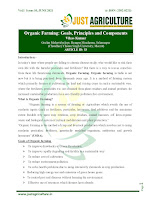Bacteria: Definition, Structure and types of bacteria based on shape
Bacteria:-
Bacteria are primitive prokaryotic
microorganism with a rigid cell wall and their nuclear material is not
separated from the cytoplasm by a nuclear membrane and there is no mitotic
apparatus.
Structure of Bacterial Cell:-
Bacterial cells exhibit a typical prokaryotic structure:-
1. Flagella (Singular: Falgellum):-
Flagella are hair like helical structures that protrude through the cell wall
and are usually exceeding the length of bacteria. Bacterial flagella are
usually very thinner than that of eukaryotes. Individual flagellum composed of
a basal body associated with cytoplasmic membrane (Kinetoplast) and cell wall;
a short hook and a helical filament. Filament is made up of protein namely
flagellin.
2. Pili/Fimbriae:-
These are short, fine, filamentous, non helical appendages. Chemically they are
made up of a protein namely pilin. They mainly play a important role in
adhering bacterial cells to the host surface and conjugation. Mostly gram –ve
bacteria have pilli.
3. Capsule:-
This is the outermost layer of bacterial cell. Capsule is slimy or gummy or
viscous in nature forming a envelop around the cell wall and synthesized by
cell membrane. Capsule offer protection to the bacterial cell against
desiccation.
4. Cell Wall:-
Cell wall is relatively thin, rigid and that allows inward passage of nutrients
and outward passage of waste materials and digestive enzymes. All materials
present inside the cell wall is called protoplast. Exterior to this, there is a
layer made up of peptidoglycan (or) murein which gives stable form and
mechanical strength to the cell. The peptidoglycan layer is again surrounded by
another outer membrane that is rich in phospholipids proteins,
lipopolysaccharides.
5. Cytoplasmic Membrane:-
It is present immediately beneath the cell wall. The cytoplasmic membrane
composed of protein (50%), lipids (25%) and carbohydrate (25%) and have three
distinguished unique function.
a). It behave as osmotic barrier so as to maintain
favourable intracellular osmotic pressure.
b). Act as house of permease (specific active
transport system).
c). Act as a site for enzymatic reaction involved in
energy metabolism.
6. Cytoplasm:-
It comprises of all the different substances and structures except nucleus
inside the cell membrane. All particulate matter in the cytoplasm is surrounded
by and suspended in an aqueous fluid or matrix.
7. Cytoplasmic Organs:-
i) Ribosome:-
Minutely granulated, diffused scattered macro molecular RNA protein bodies
accumulated close to the cell membrane. They have the sedimentation
co-efficient of 70s (swedsberg units).
ii) Chromatophores:-
This may be present in photosynthetic cells and are self duplicating like
chloroplast. Plant pathogenic bacteria does not have chromatophore.
iv) Nucleus:-
Nucleus of the prokaryotic microorganism are more precisely called as nucleoid
as if they neither have a distinguished closed nuclear membrane nor a mitotic
apparatus.
Types of bacteria (Based on their shape):-
The shape of the bacterium is governed by the rigid
cell wall. Usually bacteria have three principal shapes:-
(1). Coccus:-
These are spherical in shape, may be arranged singly (micrococcus), in pairs
(diplococcus), chains (strapto coccus) in box like cubical poekets (sarcinae),
inetrads (Pair of four cells in same plane) or irregular grape like clusters
(Staphylococcus).
(2). Bacillus:-
These are straight rod or cylindrical or ellipsoidal in shape, occur mostly
singly, sometimes (microbacilli) in pairs (diplobacilli), in chains (Streptobacilli)
or in parallel palisade like arrangements.
(3). Spirillum:-
These are cork screw shaped i.e the rods that are helically curved with a
twist. Rod shape bacteria with less than one complete turn or twist have
vibrioid shape where as those with one or more complete turns have a helical
shape.
Accordingly the rod shape bacteria are grouped as:-
1. Atrichous -
With out flagella (eg) Xylella sp.
2. Monotrichous -
Single flagellum at one end (eg) Xanthonomas sp.
3. Cephalotrichous -
Several numerous flagella at one pole (eg) Pseudomonas fluorescens
4. Amphitrichous -
Atleast one flagellum at each pole (eg) Pseudomonas spp
5. Peritrichous -
Flagella protruding from all portion of its surface (eg) Erwinia spp.
6. Lophotrichous -
Two or more flagella at both the poles of the bacterium. Mose of the spirillum
type of bacteria are the common examples.










0 Comments